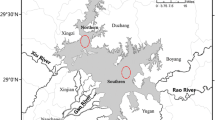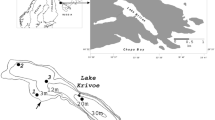Abstract
Potential body size-trophic position relationships of the Darkbarbel catfish Pelteobagrus vachelli (Richardson 1846) were examined using stable isotope analysis. Pelteobagrus vachelli is a benthic feeding fish from Lake Poyang, the largest freshwater lake in China. Two-source mixing model with mussel (Corbicula fluminea) and snail (Bellamya aeruginosa) as baseline primary consumers of planktonic and benthic food webs, respectively, was used to estimate contribution of carbon derived from planktonic vs. benthic food web. Results showed that as an indicator of trophic position, δ15N was negatively correlated with the body length and weight of the fish; on the other hand, as an indicator of the end-member food sources, δ13C was not correlated with fish size. The mixing model results showed that the averaged trophic position of our sampled 3.3–12.7 cm Pelteobagrus vachelli was 3.1 ± 0.2 and derived 68 ± 27% of their food from the benthic food web, confirming that the feeding behavior of the catfish favors benthic food sources.



Similar content being viewed by others
References
Akin S, Winemiller KO (2008) Body size and trophic position in a temperate estuarine food web. Acta Oecol 33:144–153
Barter M, Gang L, Cao L et al (2005) Waterbird survey of the middle and Lower Yangtze River floodplain in February. Chinese Forestry Publishing House, Beijing
Cabana G, Rasmussen JB (1996) Comparison of aquatic food chains using nitrogen isotopes. Proc Natl Acad Sci 93:10844–10847
Church MR, Ebersole JL, Rensmeyer KM, Couture RB, Barrows FT, Noakes DLG (2009) Mucus: a new tissue fraction for rapid determination of fish diet switching using stable isotope analysis. Can J Fish Aquat Sci 66:1–5
Cohen JE, Pimm SL, Yodzis P, Saldana J (1993) Body sizes of animal predators and animal prey in food webs. J Anim Ecol 62:67–78
Craig H (1957) Isotopic standards for carbon and oxygen and correction factors for mass- spectrometric analysis of carbon dioxide. J Geochim Cosmochim Acta 12:133–149
Cucherousset J, Aymes JC, Santoul F, Cereghino R (2007) Stable isotope evidence of trophic interactions between introduced brook trout Salvelinus fontinalis and native brown trout Salmo trutta in a mountain stream of south-west France. J Fish Biol 71:210–223
Du JR (1963) Study on reproduction and feeding habits of Pseudobagrus fulvidraco in Lake Liangzi. Chin J Zool 2:74–77
France RL (1995) Differentiation between littoral and pelagic food webs in lakes using stable carbon isotopes. Limnol Oceanogr 40:1310–1313
Gearing JN (1991) The study of diet and trophic relationships through natural abundance 13C. In: Coleman DC, Fry B (eds) Carbon isotope techniques. Academic, San Diego, pp 201–218
Gorokhova E, Hansson S, Hoglander H, Andersen CM (2005) Stable isotopes show food web changes after invasion by the predatory cladoceran Cercopagis pengoi in a Baltic Sea bay. Oecologia 143:251–259
Gu B, Schelske CL, Hoyer MV (1996) Stable isotope of carbon and nitrogen as indicators of diet and trophic structure of the fish community in a shallow hypereutrophic lake. J Fish Biol 49:1233–1243
Guan S, Lang Q, Zhang B (1987) Aquatic vegetation of Lake Poyang. Acta hydrobiol Sin 11:9–21
Hecky RE, Hesslein RH (1995) Contributions of benthic algae to lake food webs as revealed by stable isotope analysis. J Am Benthol So 14:631–653
Jennings S, Mackinson S (2003) Abundance-body mass relationships in size-structured food webs. Ecol Lett 6:971–974
Jeppesen E, Jensen JP, Søndergaard M, Lauridsen T, Pedersen LJ, Jensen L (1997) Top-down control in freshwater lakes: the role of nutrient state, submerged macrophytes and water depth. Hydrobiologia 342–343:151–164
Kolasinski J, Frouin P, Sallon A, Rogers K, Bruggemann HJ, Potier M (2009) Feeding ecology and ontogenetic dietary shift of yellowstripe goatfish Mulloidichthys flavolineatus (Mullidae) at Reunion Island, SW Indian Ocean. Mar Eco Pro Ser 386:181–195
Layman CA, Winemiller KO, Arrington DA, Jepsen DB (2005) Body size and trophic position in a diverse tropical food web. Ecology 86:2530–2535
Ma XZ, Wang W, Gan L, Yuan Y, Zhang WB (2006) Growth and development of larval and juvenile darkbarbel catfish (Pelteobagrus vachelli). J Dalian Fish Univ 21:331–335
McCutchan JH, LewisWM KC, McGrath CC (2003) Variation in trophic shift for stable isotope ratios of carbon, nitrogen, and sulfur. Oikos 102:378–390
Peterson BJ, Fry B (1987) Stable isotopes in ecosystem studies. Ann Rev Ecolog Syst 18:293–320
Pinnegar JK, Polunin NVC (1999) Differential fractionation of δ13C and δ15N among fish tissues: implications for the study of trophic interactions. Funct Ecol 13:225–231
Post DM (2002) Using stable isotopes to estimate trophic position: models, methods, and assumptions. Ecology 83:703–718
Vadeboncoeur Y, Vander Zanden MJ, Lodge DM (2002) Putting the lake back together: reintegrating benthic pathways into lake food web models. Bioscience 52:44–54
Vander Zanden MJ, Cabana G, Rasmussen JB (1997) Comparing trophic position of freshwater fish calculated using stable nitrogen isotope ratios (δ15N) and literature dietary data. Can J Fish Aquat Sci 54:1142–1158
Vander Zanden MJ, Casselman JM, Rasmussen JB (1999) Stable isotope evidence for the food web consequences of species invasions in lakes. Nature 401:464–467
Vander Zanden MJ, Chandra S, Allen BC, Reuter JE, Goldman CR (2003) Historical food web structure and restoration of native aquatic communities in the Lake Tahoe (California-Nevada) Basin. Ecosystems 6:274–288
Vander Zanden MJ, Hulshof M, Ridgway MS, Rasmussen JB (1998) Application of stable isotope techniques to trophic studies of age-0 smallmouth bass. Trans Am Fish Soc 127:729–739
Vander Zanden MJ, Vadeboncoeur Y (2002) Fishes as integrators of benthic and pelagic food webs in lakes. Ecology 83:2152–2161
Vizzini S, Mazzola A (2009) Stable isotopes and trophic positions of littoral fishes from a Mediterranean marine protected area. Environ Biol Fish 84:13–25
Wang HZ, Xu QQ, Cui YD, Liang YL (2007) Macrozoobenthic community of Poyang Lake, the largest freshwater lake of China, in the Yangtze floodplain. Limnology 8:65–71
Xu J, Zhang M, Xie P (2010) Sympatric variability of isotopic baselines influences modeling of fish trophic patterns. Limnology. doi:10.1007/s10201-010-0327-z
Xu J, Zhang M, Xie P (2007) Size-related shifts in reliance on benthic and pelagic food webs by lake anchovy. Ecoscience 14:170–177
Yoshii K, Melnik NG, Timoshkin OA, Bondarenko NA, Anoshko PN, Yoshioka T, Wada E (1999) Stable isotope analyses of the pelagic food web in Lake Baikal. Limnol Oceanogr 44:502–511
Zhang TL, Li ZJ (2007) Fish resources and fishery utilization of Lake Poyang. J Lake Sci 19:434–444
Zhu HH, Zhang B et al (1997) The Lake Poyang. Press of University of Science and Technology of China, Hefei, pp 1–12
Zimmerman MS, Schmidt SN, Krueger CC, Vander Zanden MJ, Eshenroder RL (2009) Ontogenetic niche shifts and resource partitioning of lake trout morphotypes. Can J Fish Aquat Sci 66:1007–1018
Acknowledgments
We would like to express our sincere thanks to Yuwei Chen, Lu Zhang and the staff of Lake Poyang Laboratory for Wetland Ecosystem Research, Nanjing Institute of Geography and Limnology, Chinese Academy of Sciences, for their help in field work and data collection in Lake Poyang. Input from anonymous reviewers also helped improve this manuscript substantially. This study was supported by the 973 Plan (Grant No. 2009CB421106), the National Science and Technology Support Plan (Grant No. 2006BAC08B05), and the National Natural Science Foundation of China (Grant No. 30870428). Funding was also awarded to JX by the K. C. Wong Education Foundation and the Knowledge Innovation Program of the Chinese Academy of Sciences.
Author information
Authors and Affiliations
Corresponding author
Additional information
An erratum to this article can be found at http://dx.doi.org/10.1007/s10641-011-9883-2
Rights and permissions
About this article
Cite this article
Wang, Y., Yu, X. & Xu, J. Decreased trophic position as a function of increasing body size of a benthic omnivorous fish from the largest freshwater lake in China. Environ Biol Fish 91, 505–512 (2011). https://doi.org/10.1007/s10641-011-9808-0
Received:
Accepted:
Published:
Issue Date:
DOI: https://doi.org/10.1007/s10641-011-9808-0




